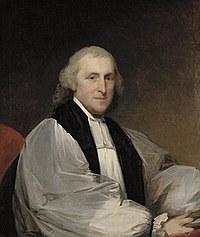Benutzer:Bhuck/William White (Bishop of Pennsylvania)
The Most Reverend William White (April 4, 1748 N.S. – July 17, 1836) was the first and fourth Presiding Bishop of the Episcopal Church, USA (1789; 1795–1836), the first Bishop of the Diocese of Pennsylvania (1787–1836), and the second United States Senate Chaplain (appointed December 9, 1790).
Ausbildung und Ordination
Born in Philadelphia, White began his education at Philadelphia College (which was later known as the University of Pennsylvania), taking his B.A. in 1765 and his A.M. about three years later. In 1770 he sailed for England on the ship Britannia, for his ordination as a priest, which took place in the Chapel Royal at St. James's Palace. He subsequently returned to England on two occasions: once in 1772 and again in 1787, when he was consecrated bishop by the Archbishop of Canterbury, the Archbishop of York, the Bishop of Bath and Wells, and the Bishop of Peterborough. In 1781, he graduated D.D. from the University of Pennsylvania.
An seiner Bischofsweihe beteiligt waren:
- The Most Reverend John Moore, 88th Archbishop of Canterbury
- The Most Reverend William Markham, 77th Archbishop of York
- The Right Reverend Charles Moss, Bishop of Bath and Wells
William White was the 2nd bishop consecrated in the Episcopal Church.
Geschichte
Rector of St. Peter's and of Christ Church for 57 years, White also served as Chaplain of the Continental Congress from 1777 to 1789, and subsequently as Chaplain of the Senate. White was the only Episcopal cleric in Pennsylvania who sided with the American revolutionary cause, while the other ordained priests remained loyal to the British.
The bishop took an active role in creating several charitable and educational institutions. In 1785 he founded The Episcopal Academy, to educate the sons of Philadelphia's Episcopalian residents to become to leaders in society. He also founded the Pennsylvania Institution for the Deaf and Dumb, now known as the Pennsylvania School for the Deaf, in 1820. He served the school as president for the next 16 years. He also participated in prison ministry in Philadelphia, becoming the first president of the Philadelphia Society for the Alleviation of Miseries of Public Prisons, which attracted the participation of numerous Quakers. In 1795 Bishop White raised funds to create a school (built on Race Street between 4th and 5th) for black and Native American children. He also helped to create a Magdalen Society in Philadelphia in 1800 for ”unhappy females who have been seduced from the paths of virtue and are desirous of returning to a life of rectitude.” This was the first institution of this kind in the United States.[1] (See also: Magdalen Asylum)
He was a member of the American Philosophical Society, along with many other prominent Philadelphians, including Benjamin Franklin. White was not remarked for his oratorical skills. Instead, he gained the esteem of the Philadelphia community through his ongoing charitable works, especially during the outbreaks of yellow fever in that city throughout the 1790s, because he remained to tend the ill when many other wealthy inhabitants fled to the countryside. He was a trustee of the University of Pennsylvania from 1774 until his death. During his tenure as trustee, he also served as Treasurer (1775–1778) and President (1790–1791) of the Board of Trustees.
Familien- und Privatleben
Bishop White was married to Mary Harrison (1750–1797), who came from a landed Virginia family. Mary's father, Capt. Henry Harrison, had also been the Mayor of Philadelphia from 1762-1763. The Whites had eight children, only three of whom survived to adulthood. As a widower, Bishop White supported seven of his grandchildren. In 1813, the bishop's widowed daughter Elizabeth brought her two daughters to live in the house. Elizabeth, called "Betsy" by the family, managed the household for nearly twenty years until her death in 1831. After the death of the Whites' son-in-law and daughter Mary, the Bishop and Betsy brought his five grandchildren (through Mary) into his home where they lived for the ten years leading up to his death. White's younger sister Mary was married to Robert Morris, who was known as the "Financier of the Revolution" for securing funding for the colonial cause.
Bishop White's household included a free African American coachman, named John, but no slaves.[2]
A lengthy obituary devoted to Bishop White in the National Gazette and Literary Register described him thus:
"...[T]he duties of the several important relations in which he stood to society were performed with undeviating correctness and suavity; he possessed the rare merit of winning the respect and love of an entire community to which he was an ornament and a blessing. His piety was deep and unfeigned; his walking humble yet dignified; his acquirements profound; in his mind the welfare of the Christian church was always the prominent consideration...He was one of those examples of steady virtue sent upon earth by Divine Providence, as if to prove how near the great pattern of perfection it is permitted to approach."[3]
Bishop White died at his home after a lingering illness, retaining his full mental faculties until the end. He was buried in the family vault at Christ Church Burial Ground on July 20, 1836, next to his brother-in-law, Robert Morris. On December 23, 1870 his remains were re-interred in the chancel of Christ Church.
Wohnhaus
His home at 309 Walnut Street in Philadelphia is today part of Independence National Historical Park. It is notable, in part, as one of the first houses to have an indoor "necessary," at a time when most privies were built outside of houses. The prominent physician Benjamin Rush lived next door.
Ehrungen
White is honored with a feast day on the liturgical calendar of the Episcopal Church (USA) on July 17.
Einzelnachweise
Literatur
- The Episcopal Church Annual. Morehouse Publishing: New York, NY (2005).


